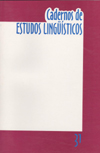Resumen
O modelamento da duração acústica no português do Brasil (PB) tornou possível a emergência de uma tipologia acentual que revela a existência de ao menos duas unidades de programação macrorrítmicas: a sílaba e o GIPC. Os pontos de máximo dos z-scores da sílaba coincidem com a posição do acento lexical enquanto os pontos de máximo dos z-scores do GIPC (coincidindo com posição de acento lexical) demarcam as fronteiras prosódicas do enunciado. Um modelo rítmico possibilitando a geração automática e simplificada da duração segmental é proposto para ser integrado em um sistema de síntese da fala em PB.
Citas
BARBOSA, P.A. & Bailly, G. Generating pauses within the z-score model. In: Progress in Speech Synthesis. van Santen, J.P.H., Sproat, R.W., Olive, J.P. & Hirschberg, J. (Eds.), New York: SpringerVerlag, 1997:365-381.
BARBOSA, P.A. & Bailly, G. Characterisation of rhythmic patterns for text-to-speech synthesis, Speech Communication, 15 (1-2), 1994:127-137.
BÖEFFARD, O. & Violaro, F. Using a hybrid model in a Text-to Speech system to enlarge prosodic modifications. International Conference on Spoken Language Processing (ICSLP ‘94), Yokohama, Japan, 1994:727-730.
BROWMAN, C.P. & Goldstein, L. Articulatory Phonology: an overview. Phonetica, 49, 1992:155-180.
BROWMAN, C.P. & Goldstein, L. Tiers in articulatory phonology with some implication for casual speech. Kingston, J. & Beckman, M.E. (Eds.). Papers in Laboratory Phonology 1. Cambridge University Press, 1990:341-376.
BROWMAN, C.P. & Goldstein, L. Towards an articulatory phonology. Phonology Yearbook, 3, 1986:219252.
CAMPBELL, N.W. Syllable-based segmental duration. In: Talking Machines: theories, models, and designs (Bailly, G. & Benoît, C. Eds.), 1992:211-224.
CAMPBELL, N.W. Automatic detection of prosodic boundaries in speech, Speech Communication, 13, 1993:343-354.
EDWARDS, J., Beckman, M.E. & Fletcher, J. The articulatory kinematics of final lengthening. J. Acoust. Soc. Am. 89 (1), 1991:369-382.
GOEDEMANS, R. & van Heuven, V.J. Duration perception in subsyllabic constituents. Proceedings of the 4th European Conference on Speech Communication and Technology (EUROSPEECH), September, 18-21st, Madrid, Spain, 2, 1995:1315-1318.
JANKER, P.M. On the influence of the internal structure of a syllable on the p-center perception. XIII International Congress of Phonetic Sciences, August 13-19, Stockolm, Sweden, 2, 1995:510-513.
KEATING, P.A. Segmental Phonology and Non-segmental Phonetics. XIII International Congress of Phonetic Sciences, August 13-19, Stockolm, Sweden, 3, 1995:26-32.
LEHISTE, I. Suprasegmentals. Cambridge, Massachussets: MIT Press, 1970.
LEINER, H.C., Leiner, A.L. & Dow, R.-S. The human cerebro-cerebellar system: its computing, cognitive, and language skills. Behavioural Brain Research, 44, 1991:113-128.
LEUNG, H.C. & Zue, V. W. A procedure for automatic alignment of phonetic transcriptions with continuous speech. Proceedings of the IEEE ICASSP, 1, San Diego, 1984:2.7.1-2.7.4.
MARCUS, S.M. Acoustic determinants of Perceptual-center (p-center) location, Perception and Psychophysics, 30(3), 1981:247-256.
MARTIN, P. L’Intonation est-elle une structure congruente à la syntaxe ? In: L’Intonation : de l’acoustique à la sémantique, Paris: Klincksieck, 1981:234-271.
MASSINI, G. A Duração no estudo do acento e do ritmo em português, Master’s thesis, Unicamp, 1991.
MONNIN & Grosjean, Les Structures de performance en français : caractérisation et prédiction, L’Année Psychologique 93, 1993:9-30.
PERKELL, J.S. Phonetic Features and the Physiology of Speech Production. In: Language Production: Speech and Talk. Butterworth, B. (Ed.). Academic Press: London. Vol 1, 1980: pp 33-372.
POMPINO-MARSCHALL, B. The syllable as a prosodic unit and the so-called P-centre effect. Forschungsberichte des Instituts für Phonetik und Sprachliche Kommunikation der Universität München, 29, 1991:65-123.
PÖPPEL, E. The Measurement of Music and the Cerebral Clock: a new theory. LEONARDO, 22(1), 1989:83-89.
ROHANI, K., Chen, M.S. & Manry, M.T. Neural subnet design by direct polynomial mapping. IEEE Transactions on Neural Nets, 3 (6), 1992:1024-1026.
SEMJEN, A., Schulze, H.-H. & Vorberg, D. Temporal control in the coordination between repetitive tapping and periodic external stimuli. Fourth Rhythm Workshop: Rhythm Perception and Production, Bourges, June, France, 1992:73-78.
SOUSA, E.M.G. Towards an Acoustic Description of Brazilian Portuguese Nasal Vowels. XIII International Congress of Phonetic Sciences, August 13-19, Stockolm, Sweden, 1995.
TESNIÈRE, L. Éléments de syntaxe structurale. Paris: Klincksieck, 1965.
TURVEY, M.T., Schmidt, R.C. & Rosenblum, L. Clock and motor components in absolute coordination of rhythmic movements. Status Report on Speech Research SR-101/102, Haskins Labs,1990.
VAN SANTEN, J.P.H. Assignment of segmental duration in text-to-speech synthesis. Computer, Speech and Language 8, 1994:95-128.
Se otorgan a la Revista CADERNOS DE ESTUDOS LINGÜÍSTICOS todos los derechos de autor relativos a los trabajos publicados. No se devolverán los originales. En virtud de su aparición en esta revista de acceso abierto, los artículos son de uso gratuito, con la debida atribución, en aplicaciones educativas y no comerciales.

